This light, tender, impossibly moist orange olive oil cake has a gorgeous, subtle natural orange flavor thanks to orange-infused olive oil. When layered with orange marmalade and creamy mascarpone frosting it's a light and creamy cake that's bursting with bright citrus flavor.
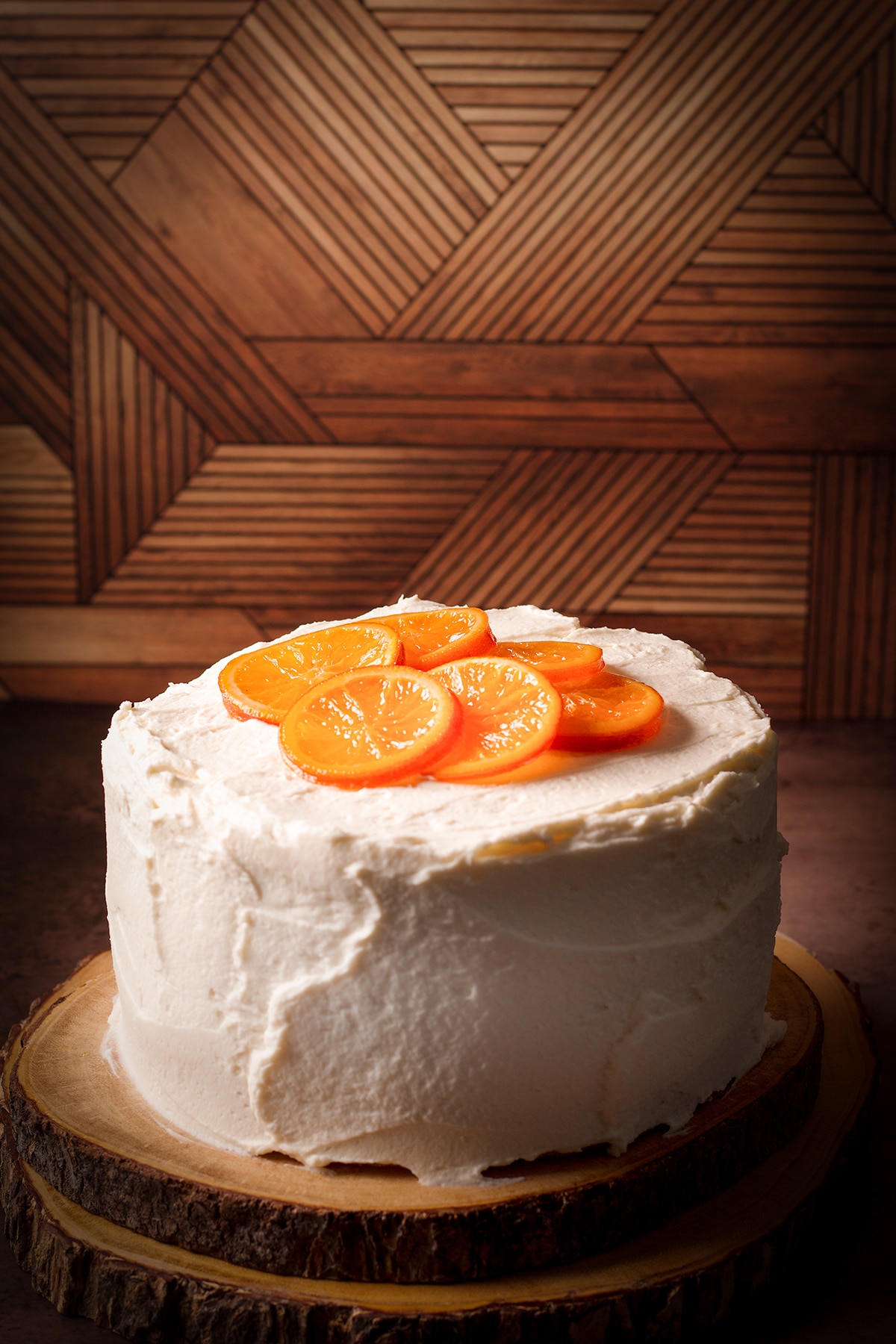
"This was so tender and flavorful, with the perfect amount of sweetness! Will make again!" - Kris
The first time I made an Olive Oil Cake I was blown away with how rich and flavorful it was. I split the cake in half and filled it with lemon mascarpone pastry cream and it not only became a favorite of my family but one of the most popular recipes I've ever published.
Since then, I've reached for olive oil every time I wanted to bake a cake with a light, tender texture and a bright fruity flavor. Using it in this Lemon Loaf Cake and in these cute little Lemon Ricotta Olive Oil Loaves was a no-brainer.
And when I considered the kind of flavor and texture I wanted to create in an orange layer cake, olive oil was the first ingredient to come to mind. Olive oil cakes are impossibly moist and the flavor is the perfect complement to citrus. Infusing olive oil with orange peel gives this cake a subtle, natural orange flavor that is really incredible.
In this recipe, I've stacked three layers of orange olive oil cake with orange marmalade and creamy Mascarpone Frosting and decorated it with easy-to-make Candied Orange Slices. But think of it as a blank canvas for any kind of citrus-flavored cake you'd like to make.
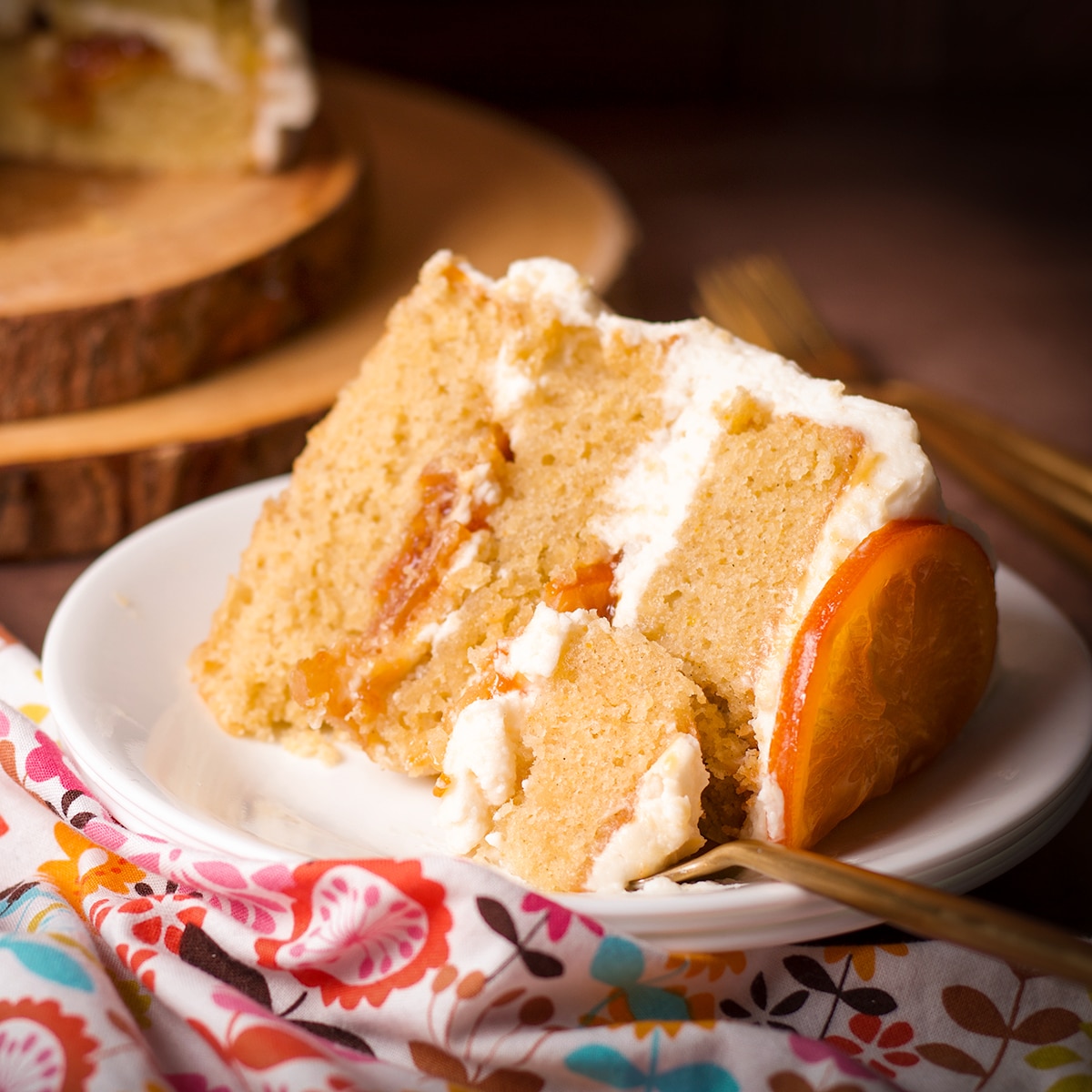

+ Subscribe to my newsletter for new and exclusive recipes in your in-box every month! As a full time traveler, living, working, cooking, and baking from a 5th wheel RV, it's also where I share our experiences of life on the road.
Ingredients Needed to Make this Recipe
This is an exceptionally soft and tender cake flavored with orange, olive oil, and a hint of cardamom. It's a stunning combination of flavors that manages to be both unique and as warm and comforting as your favorite blanket.
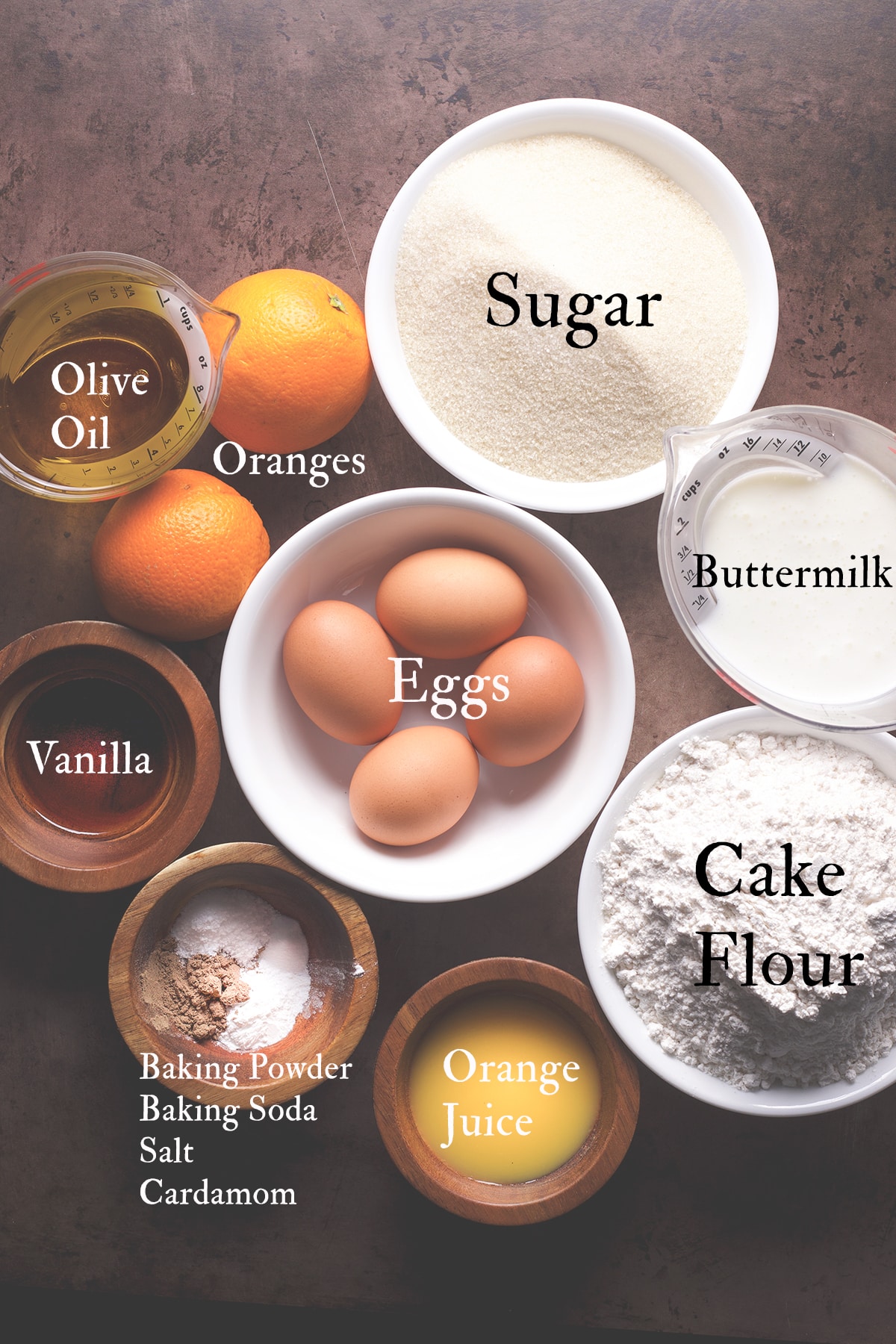
For the Cake Layers:
- Cake flour. The lower protein content in cake flour makes this cake extra soft and tender.
- Baking powder, baking soda, and salt.
- Cardamom. Cardamom, orange, and olive oil are a delicious combination! Just a teaspoon of cardamom is used in this cake, imparting a warm flavor that compliments the orange without being overpowering.
- Extra-virgin olive oil. I LOVE using olive oil in cakes. It not only makes an exceptionally moist and tender cake, it adds a gorgeous fruity flavor that's impossible to beat.
- Oranges. In this recipe, olive oil is quickly infused with oranges to give the cake a bright, fresh orange flavor.
- Eggs.
- Buttermilk. Buttermilk makes this cake exceptionally tender and gives it a rich, buttery flavor. If you don't have any buttermilk, here are several ways to make a great buttermilk substitute.
- Orange juice. Orange juice does more than just add more natural orange flavor to this cake. The little bit of extra acid in orange juice works with the buttermilk to create a soft cake with a fine crumb that's both springy and tender.
- Pure vanilla extract.
- Sugar.
To Fill and Frost this Cake:
- Orange Liquor. Brushing the cake layers with a bit of orange liquor is an optional way to infuse the cake with more orange flavor. A bit of liquor also helps keep the cake fresh for longer. Any kind of orange liquor will do, or make your own with this orange liqueur recipe!
- Orange Marmalade. Each layer of this cake is spread with orange marmalade and then mascarpone frosting. The effect is a creamy filling with a bright orange flavor that's sweet and slightly tart. Use a jar of prepared orange marmalade or follow the easy instructions below to make it.
- Mascarpone Frosting. Mascarpone frosting is subtly sweet and remarkably light. It tastes like extra rich and creamy whipped cream which is the perfect compliment to this tender, flavorful cake.
- Candied Orange Slices, optional, for decorating. I like to top this cake with a few candied orange slices (which are surprisingly easy to make!) and serve each slice with at least one of these sweet, chewy orange confections.
*See the recipe card for precise quantities.
How to Make Orange Marmalade
Cut 2 oranges and 1 lemon in half then cut each half into thin half-moon slices. Dump them into a saucepan and add 3 cups of water, 1 cup of orange juice, 4 cups of sugar, and ½ teaspoon of salt. Bring this mixture to a boil and then cover the pot and let it rest at room temperature overnight (about 12 hours).
Bring the mixture back to a boil and let it simmer over low heat for 60-90 minutes. At this point, it should be very thick. To test that it’s ready, spoon a small amount onto a plate and put it in the freezer to chill quickly. Remove the plate a minute later and test the consistency - if it’s spreadably thick, the marmalade is done. If it’s still runny, cook a while longer.
This makes a very chunky marmalade. If you want to make marmalade that has a smoother consistency, cut the oranges and lemon into chunks and pulse in a food processor before cooking.
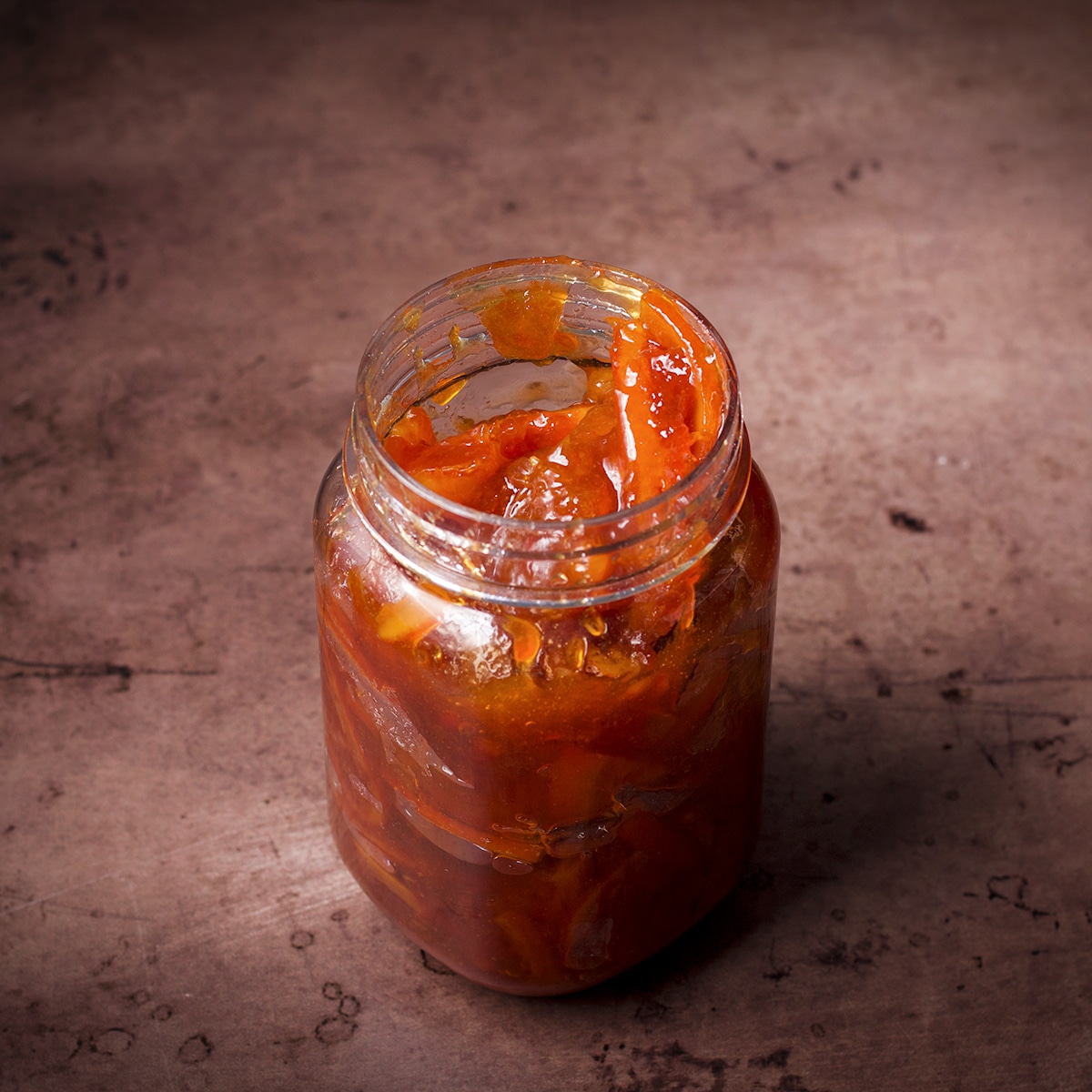
Additions, Substitutions, and Variations
Follow this same recipe to make any kind of citrus-flavored cake, lemon, lime, or even grapefruit.
- Citrus Infused Olive Oil - Instead of orange peel, blend the peel of any other kind of citrus fruit with olive oil. You can also use a combination of fruit.
- Citrus Marmalade - Follow the simple homemade marmalade recipe above to make lemon, lime, or grapefruit marmalade instead of orange marmalade.
- Fill the layers with fruit jam or curd instead of marmalade - If marmalade isn't your thing, spread a layer of any kind of fruit jam or fruit curd between the layers instead.
- Candied Citrus Slices - this simple recipe for candied orange slices can be used to make candied lemon or lime slices instead.
- Use dried fruit instead of candied - Use dried oranges or any kind of dried fruit to decorate and to serve with this cake instead of candied orange slices.
- Instead of Mascarpone Frosting - Frost this cake with Cream Cheese Buttercream, American Buttercream, Italian Meringue Buttercream, or White Chocolate Ganache Buttercream.
And, if you want to bump up the orange flavor of this cake, follow this easy recipe to make some homemade orange extract and add a few drops to the batter along with the vanilla.
Step-by-Step Photos and Instructions

This cake gets its orange flavor from orange-infused olive oil that's super quick and easy to make. Simply cut the peel from 2 oranges leaving most of the white part (the pith) behind.
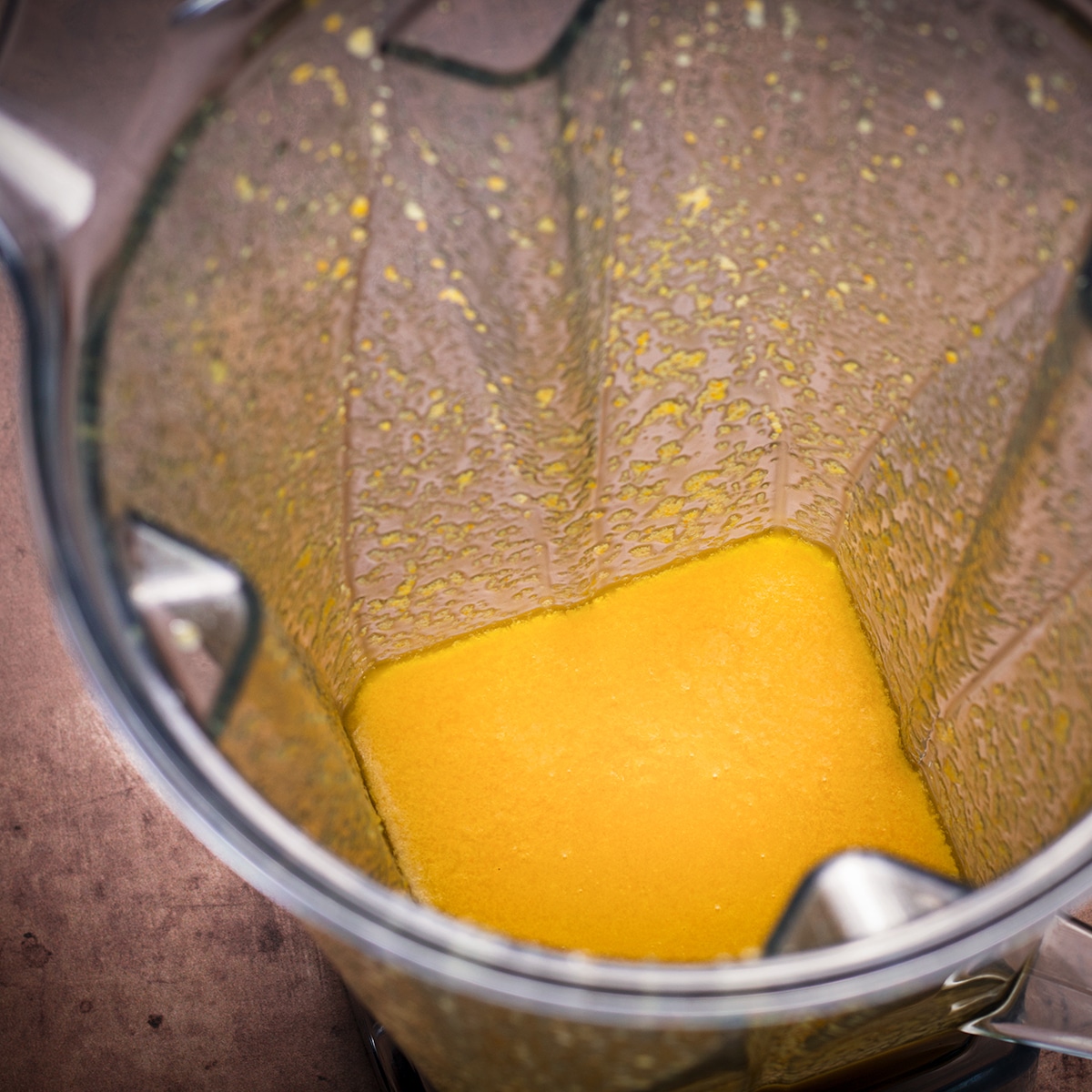
Add the peel to a blender or a food processor along with 1 cup of extra virgin olive oil. Blend/ process until the mixture is smooth. This can be done up to 48 hours in advance. Store the orange-infused olive oil in an airtight container at room temperature.
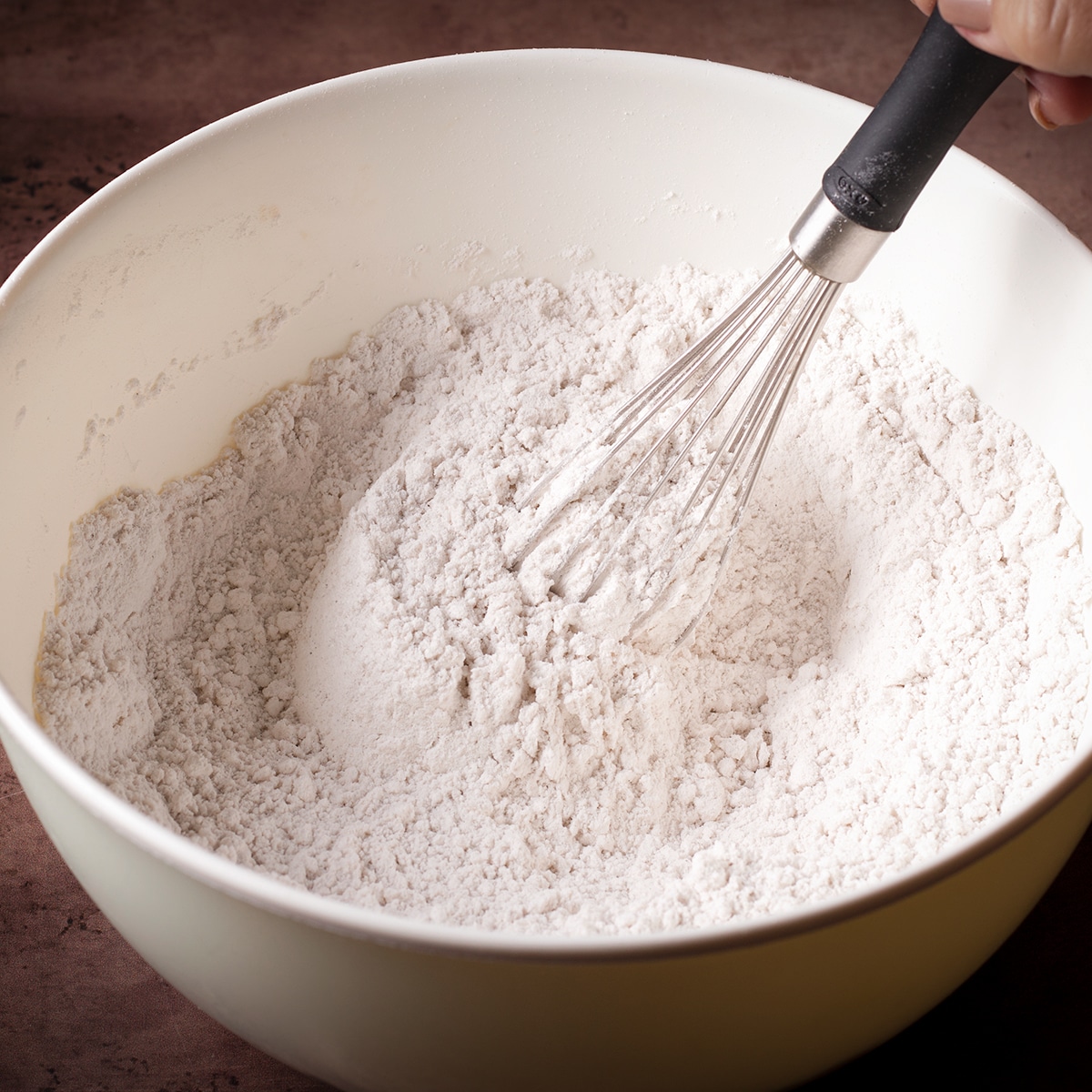
Add the cake flour, baking powder, baking soda, cardamom, and salt to a medium size bow and stir with a wire whisk to combine.
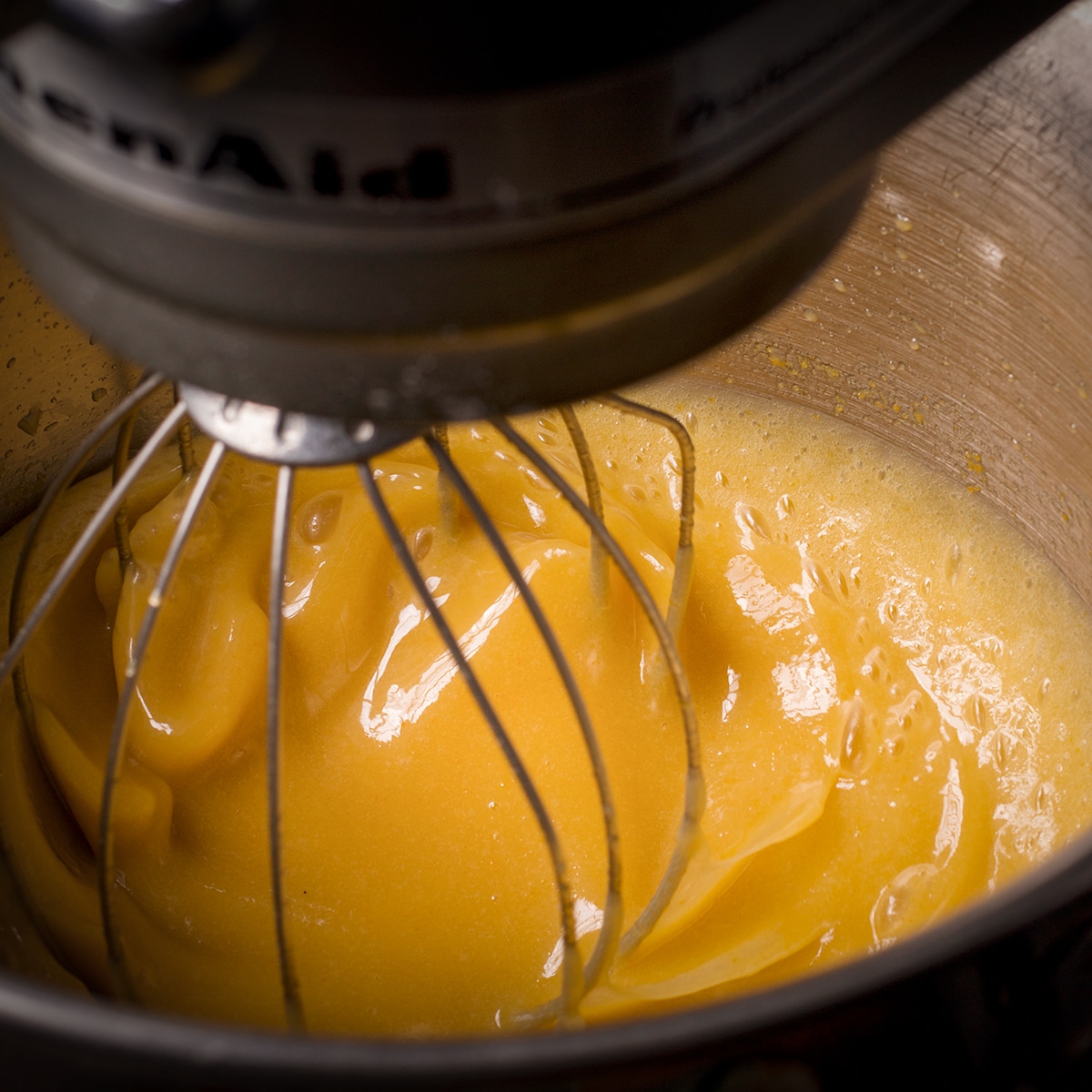
Add the orange-infused olive oil, eggs, buttermilk, orange juice, vanilla, and sugar to another bowl and beat it with an electric mixer for 2 or 3 minutes. If using a stand mixer, use the whisk attachment.
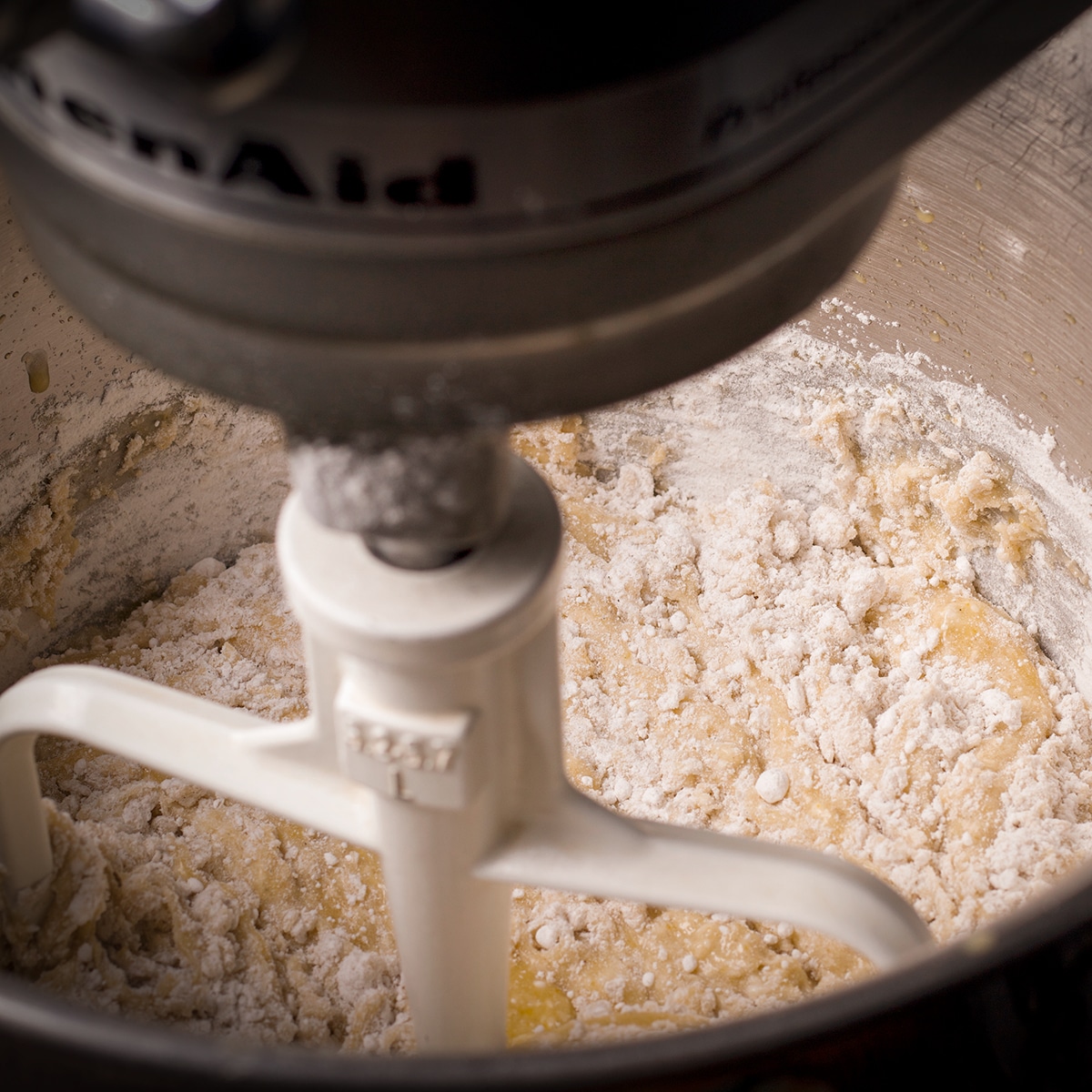
Add the dry ingredients and mix on low speed just until everything is combined. If using a stand mixer, use the paddle attachment for this step.
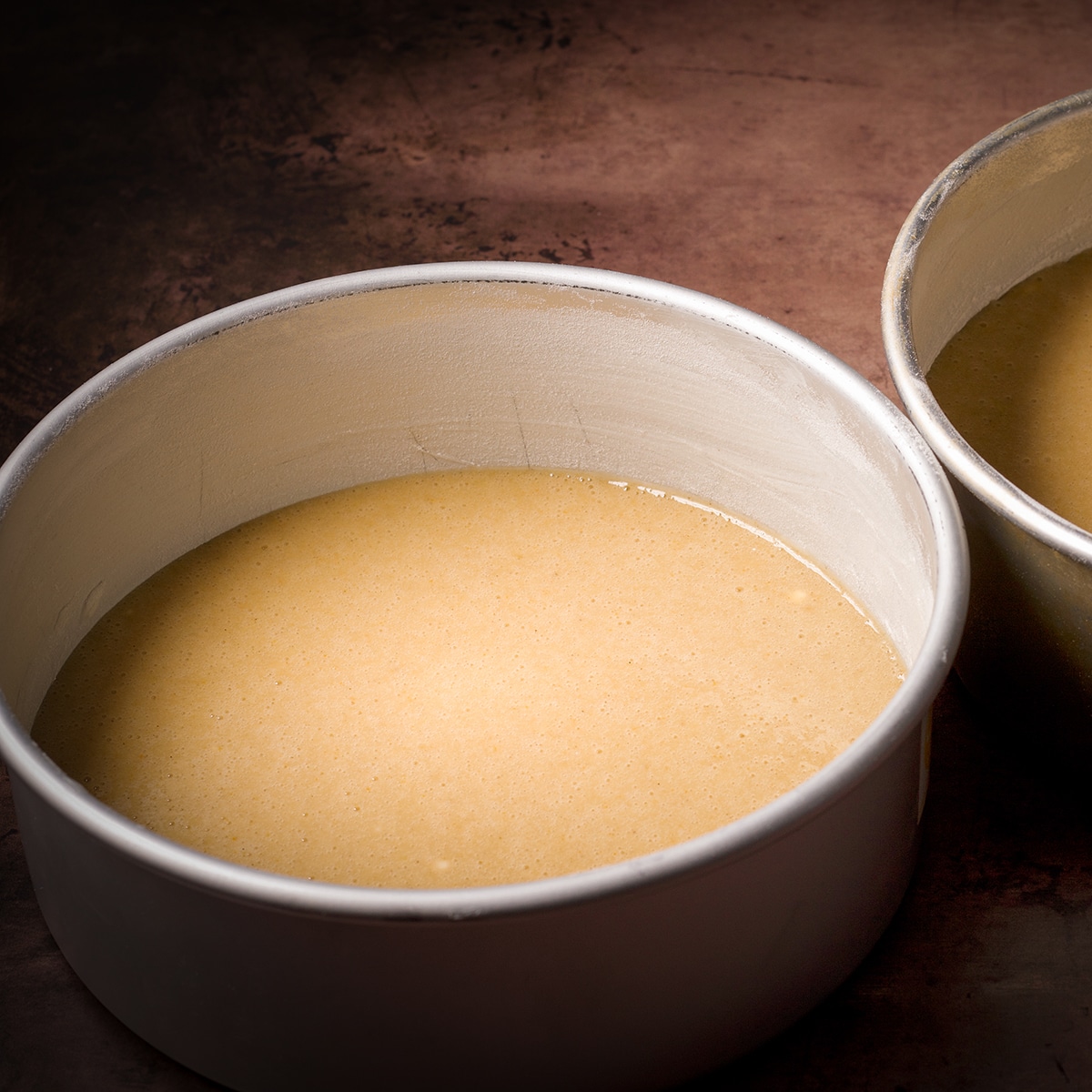
Pour the cake batter into two or three 8-inch round cake pans that have been greased and floured and lined with parchment paper. (Here's how to prepare cake pans so the cake won't stick.)
Time to bake!
Pro tip: How to use 2 cake pans to bake 3 layers
If you only have two cake pans, or if only two pans will fit inside your oven at one time, you can bake ⅓ of the batter in one pan and ⅔ of the batter in the other pan.
Once the cakes have cooled, split the larger cake in ½ horizontally for a total of 3 layers. This recipe makes a total of 1500 grams of batter. So, if you want to be precise, fill one pan with 500 grams of batter and the other pan with 1000 grams of batter.
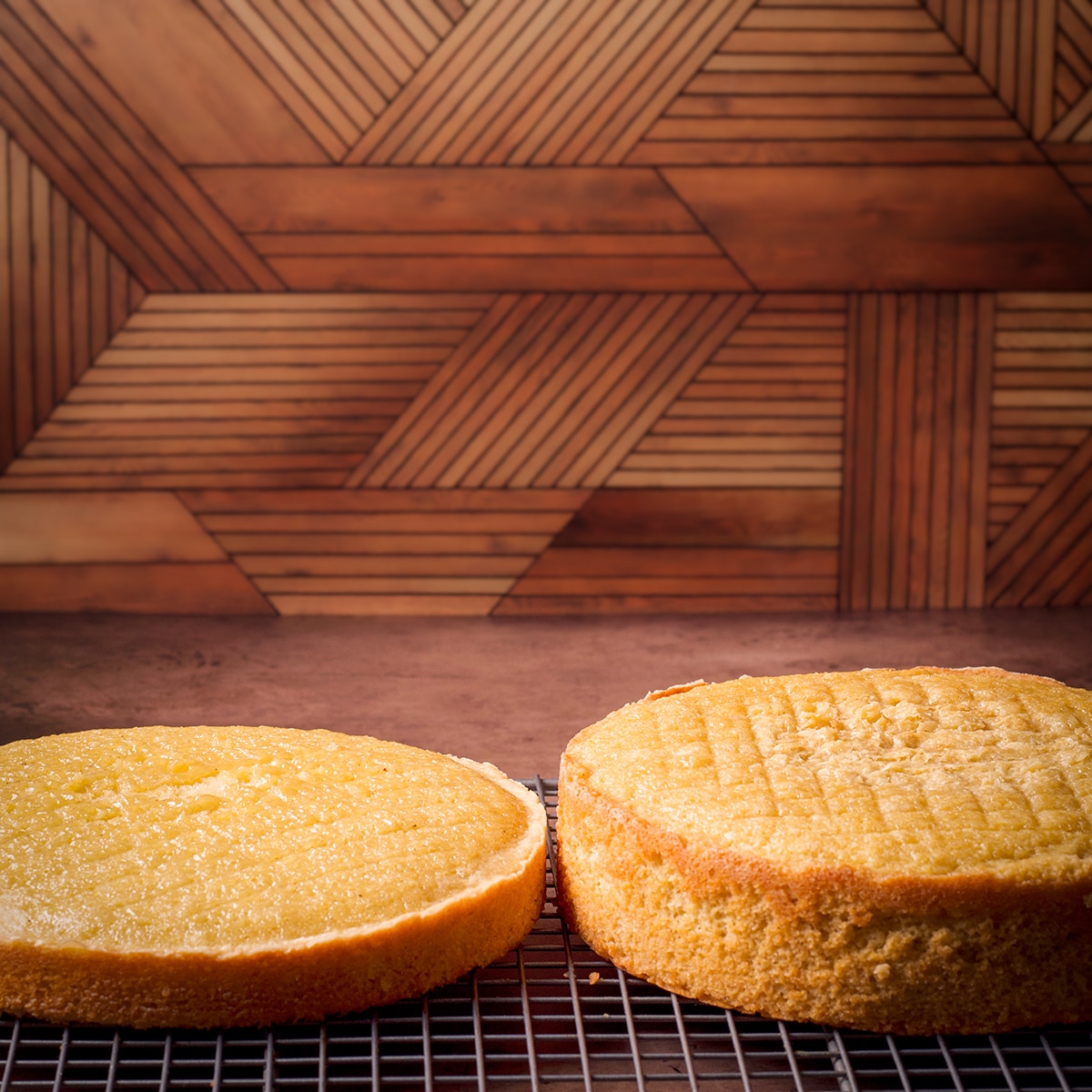
Let the cakes cool in their pans for about 5 minutes after removing them from the oven then flip them out onto wire racks and allow them to cool completely.
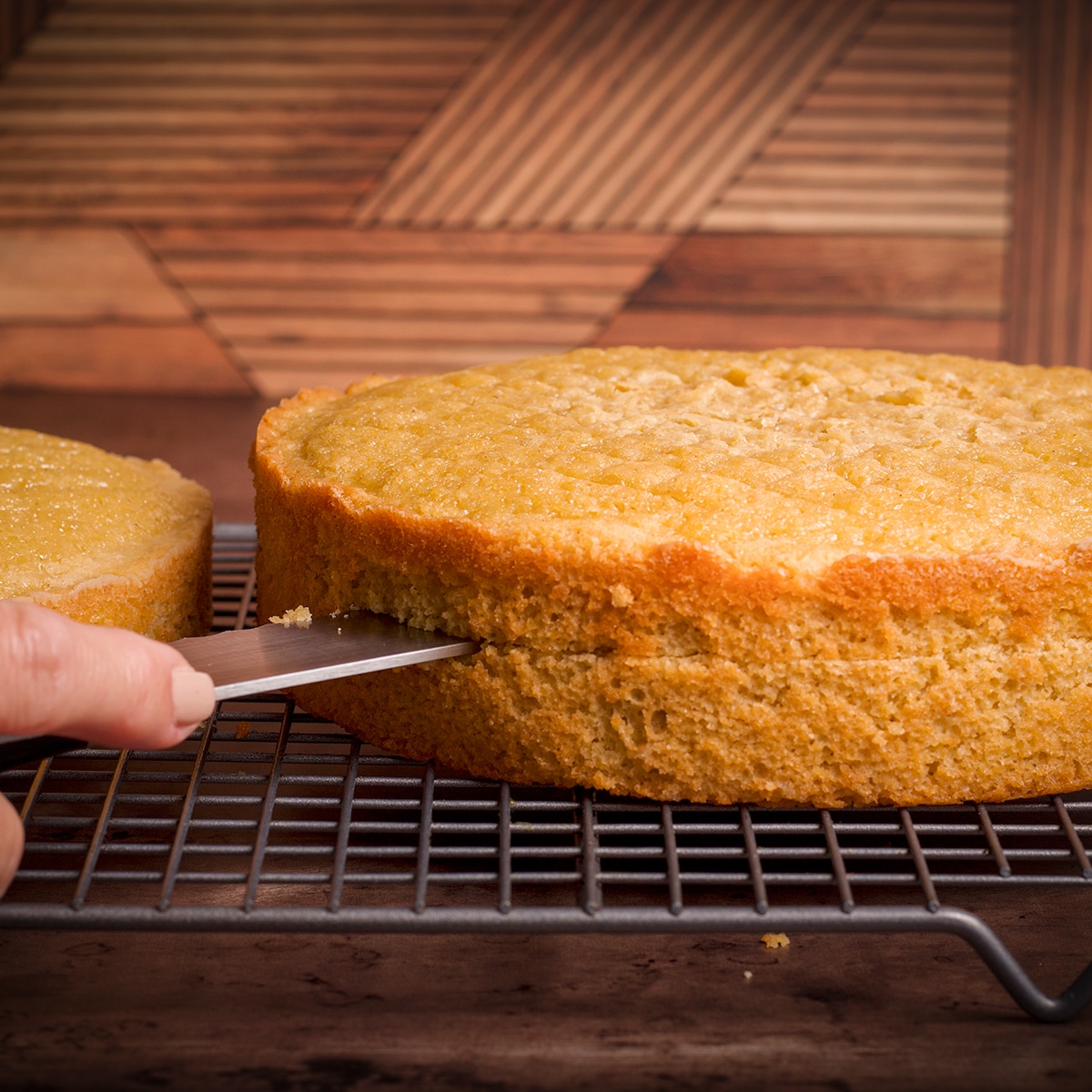
If you've followed the tip above to use two cake pans, cut the thick layer in half so you now have three layers of cake.

Brush each layer with a tablespoon or two of orange liquor. This is an optional step but infuses the cake with a deeper orange flavor and helps keep the layers moist and fresh for longer.
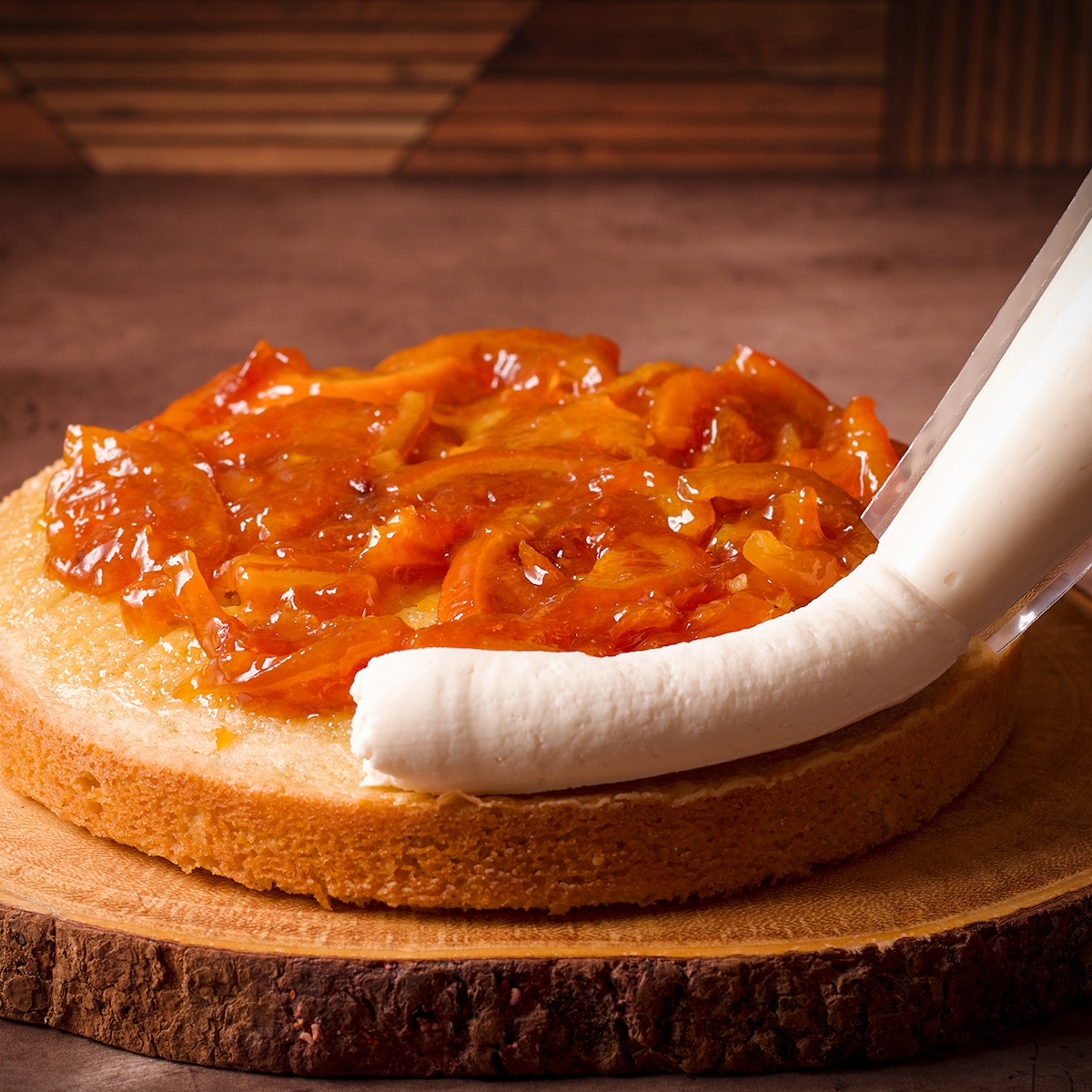
Place one layer of cake on a cake board and spread about ½ cup of orange marmalade in the center. Pipe a ring of mascarpone frosting around the edge of the cake to keep the marmalade contained.

Pipe some frosting over the top of the marmalade.
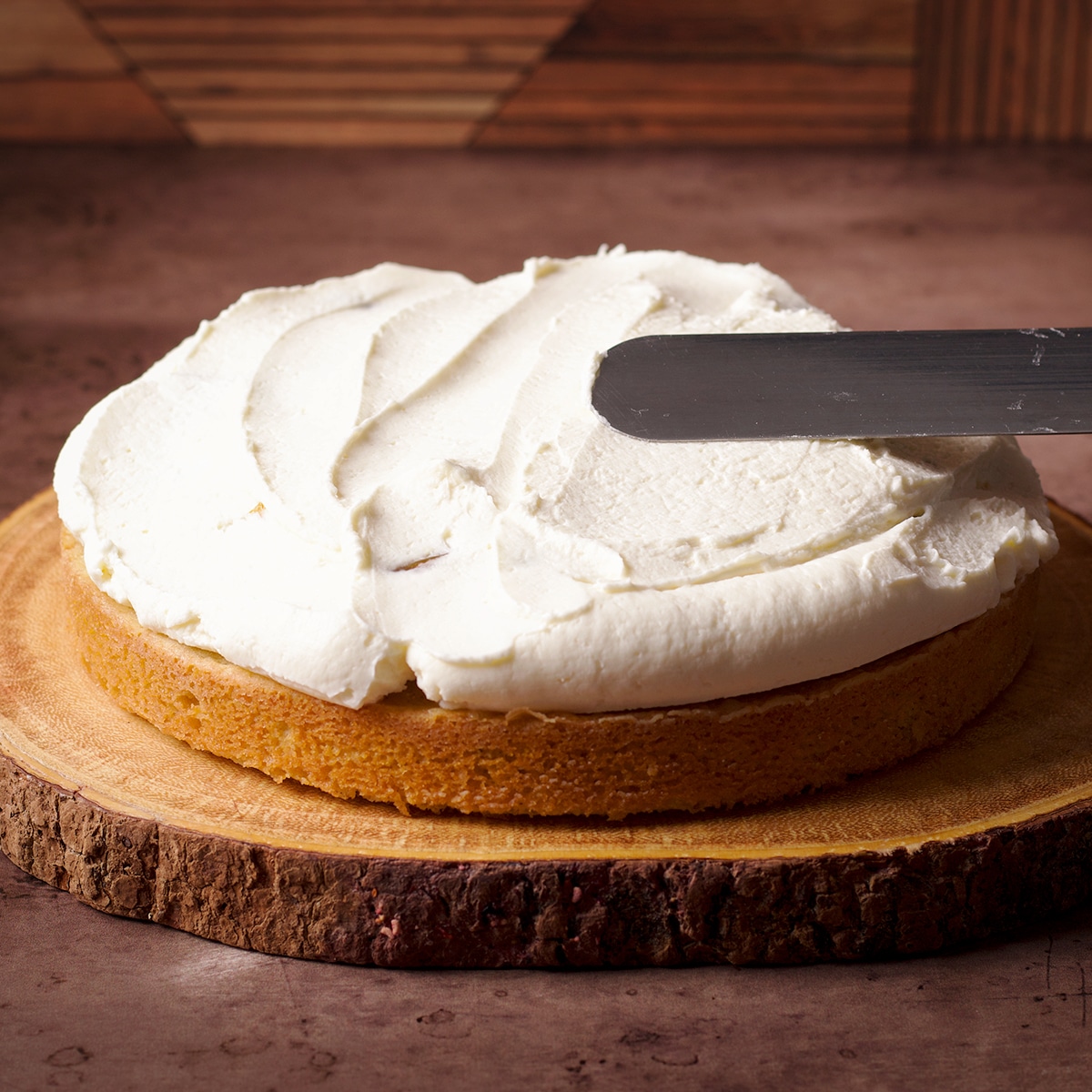
Use an icing spatula to spread the frosting over the marmalade.
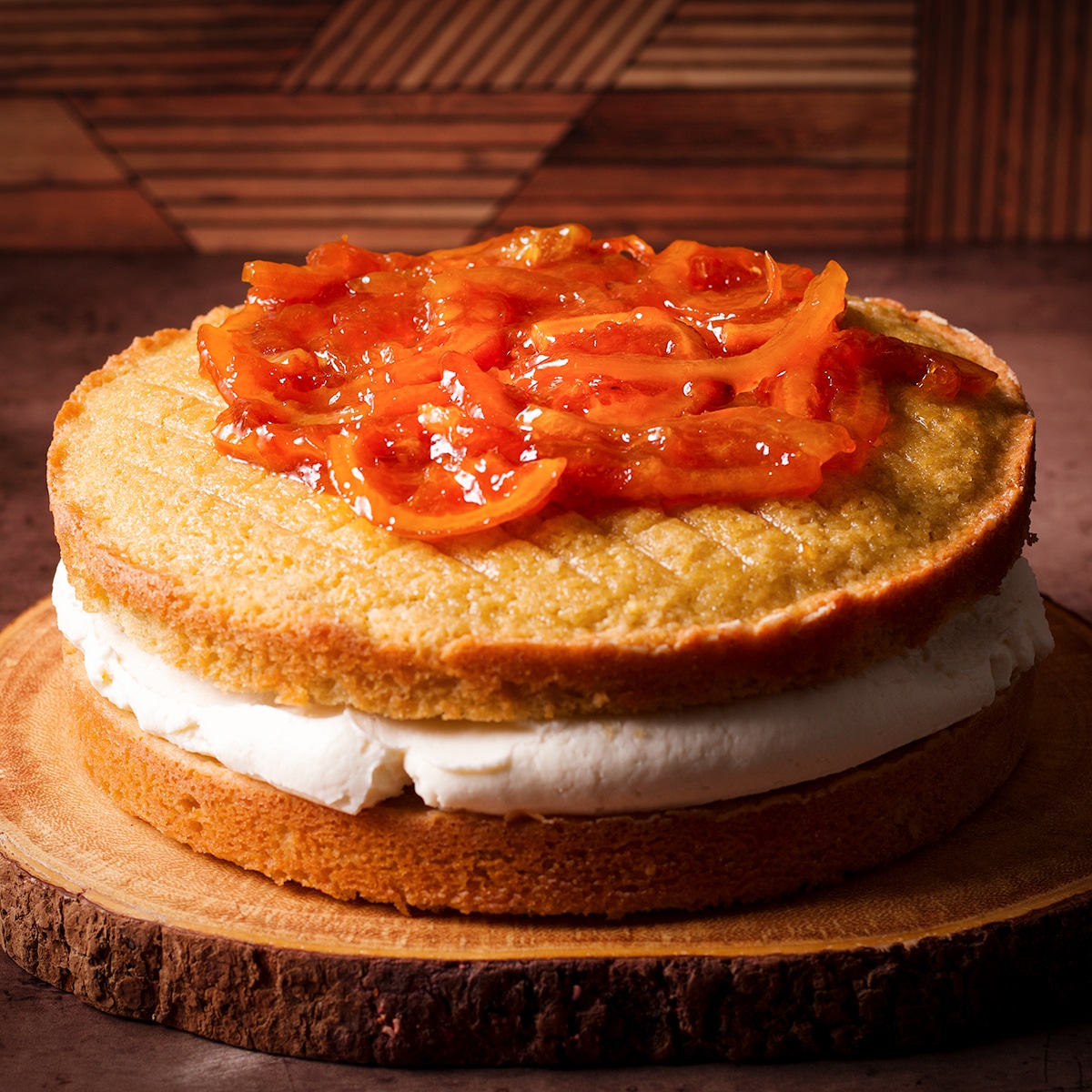
Repeat with the second layer, covering it with marmalade...
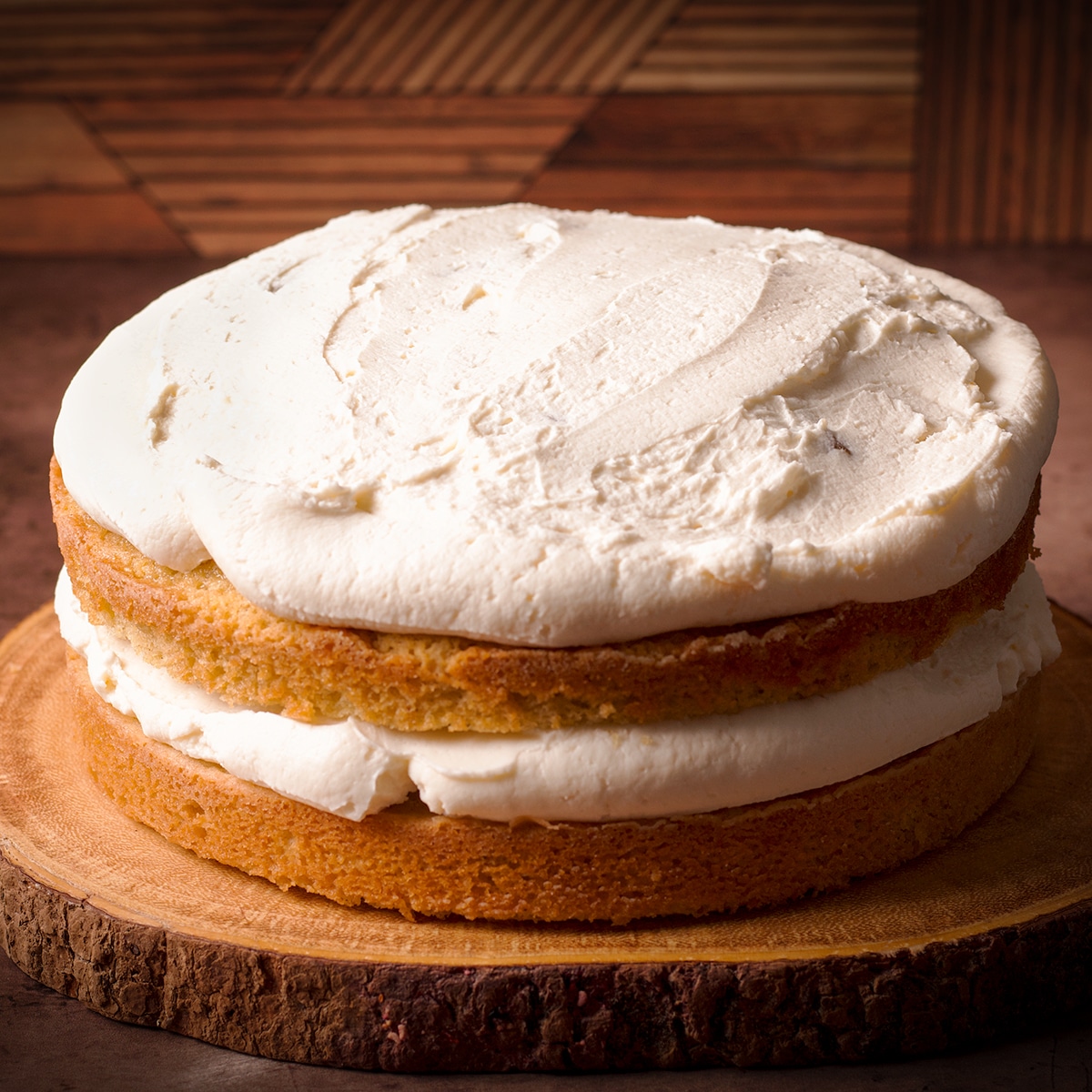
... and mascarpone frosting.
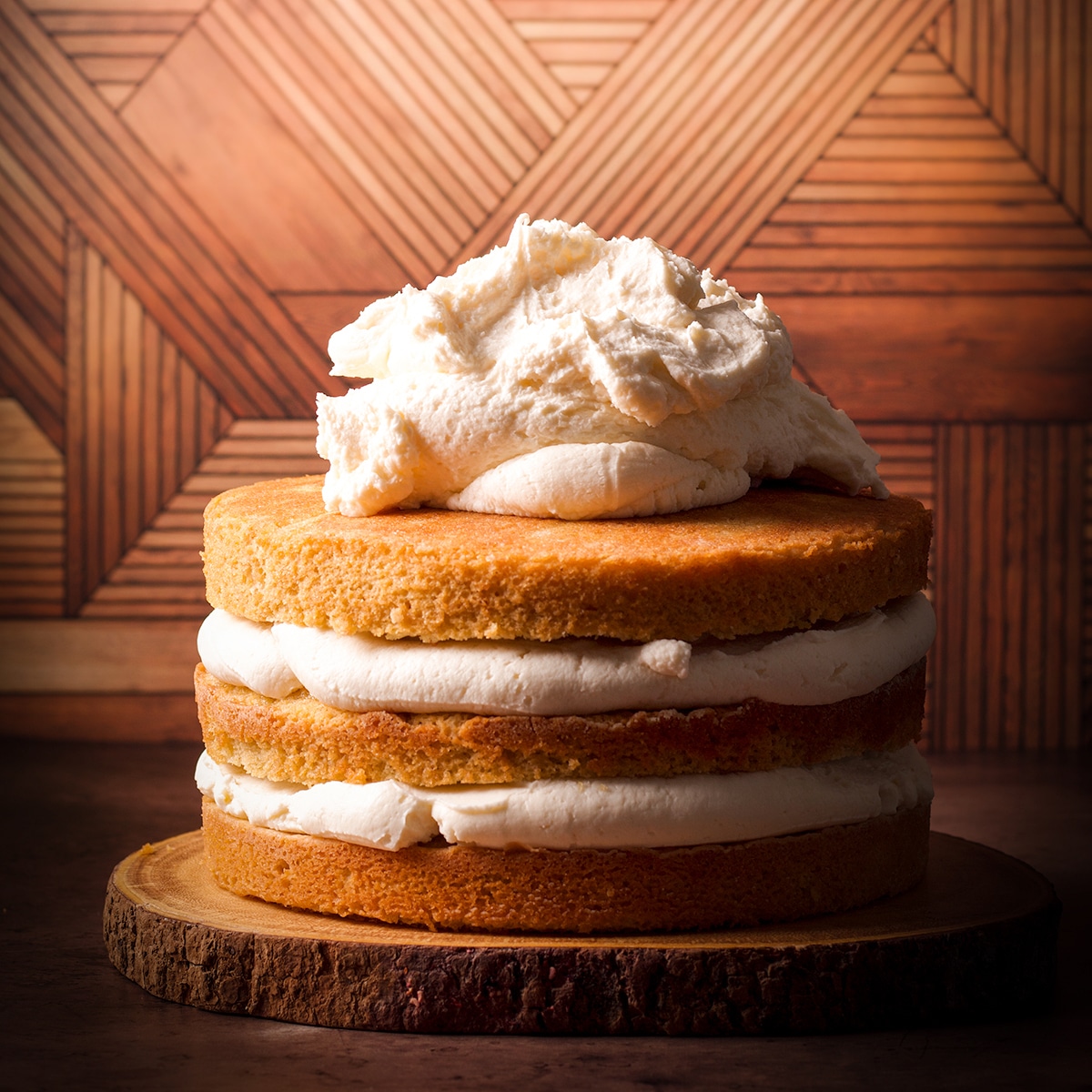
Stack the third layer on top of the second and scoop a large amount of mascarpone frosting onto the top of the cake.
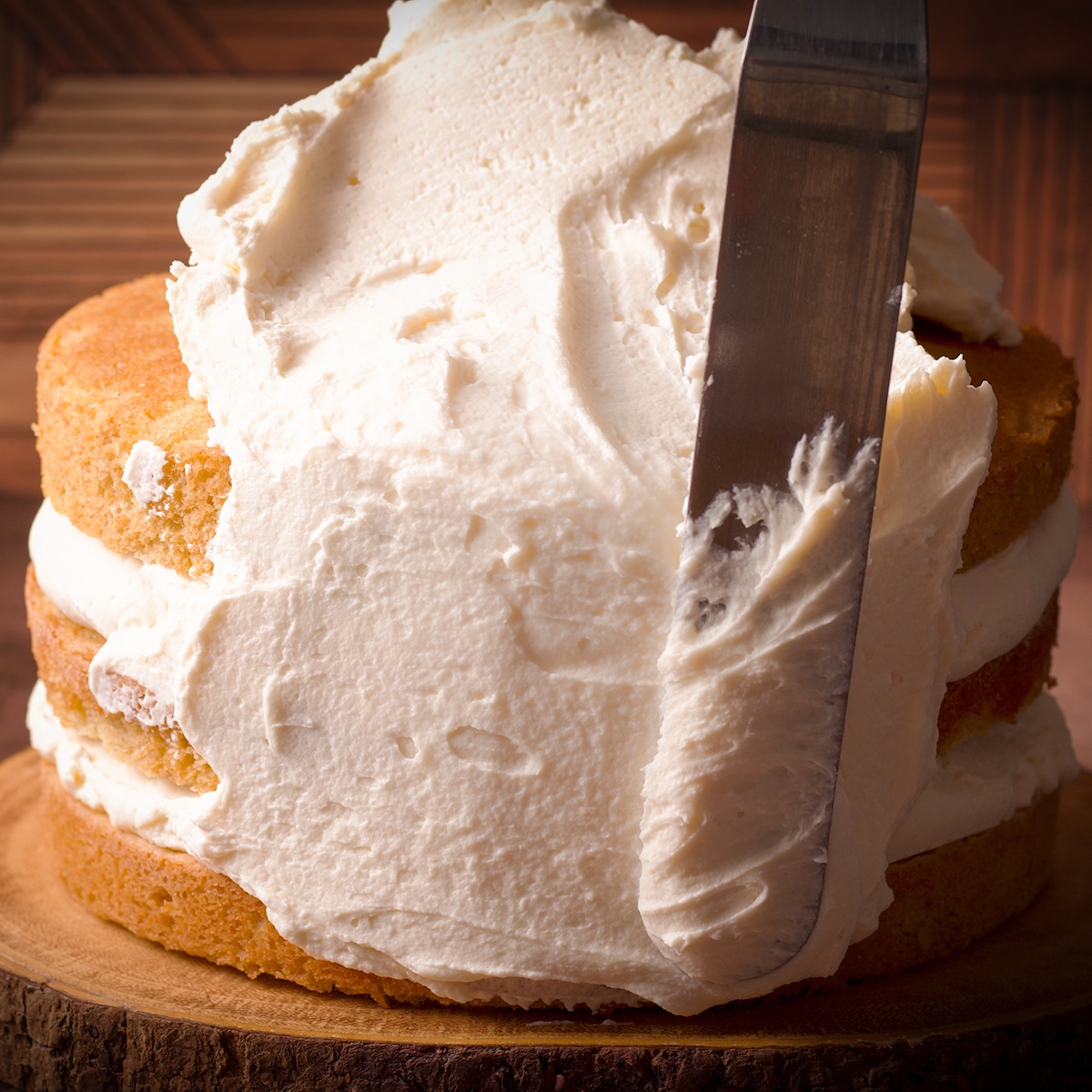
Use an icing spatula to smooth the frosting over the top of the cake, spreading it over the sides to cover the cake completely.
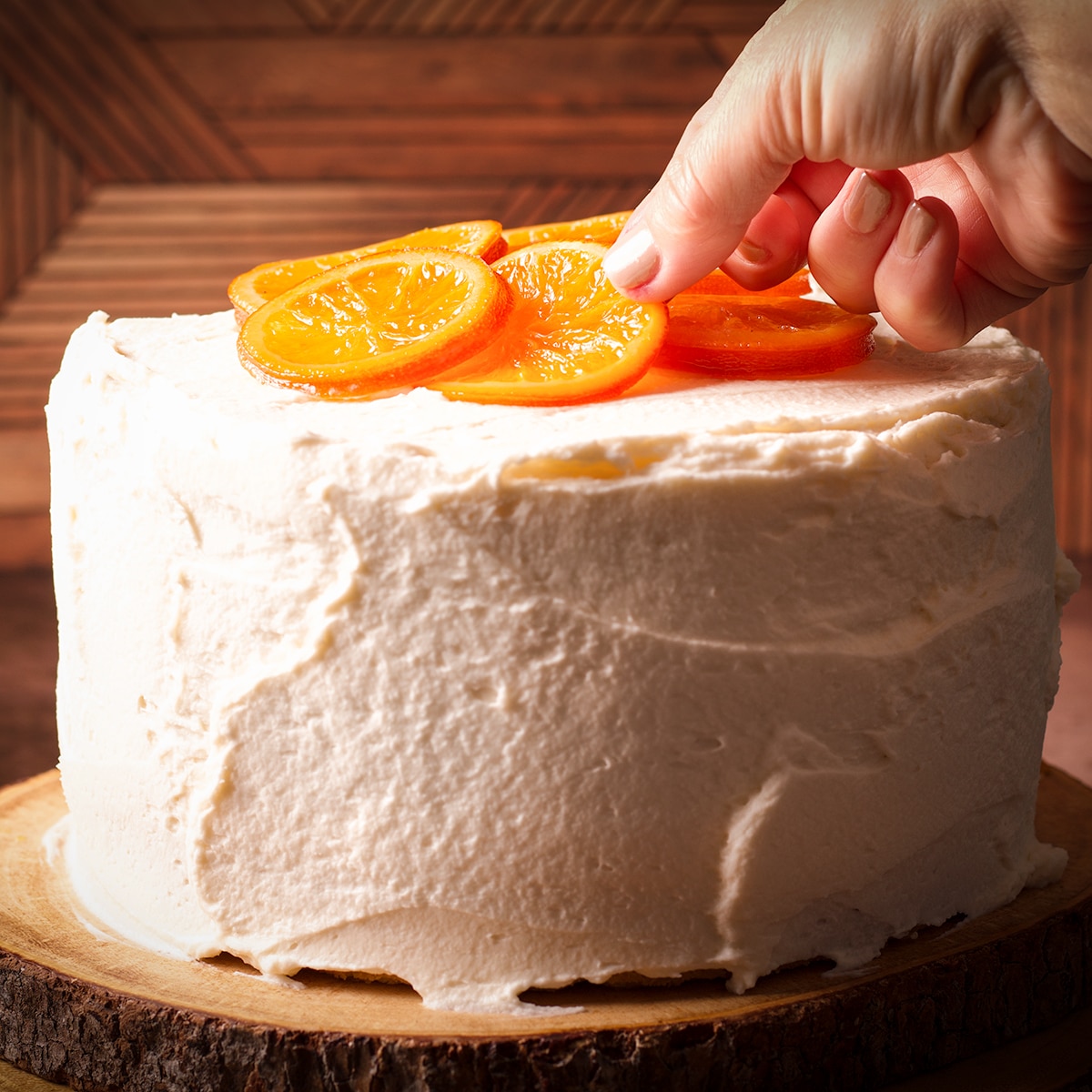
Decorate the cake with a few candied orange slices and it's ready to serve.
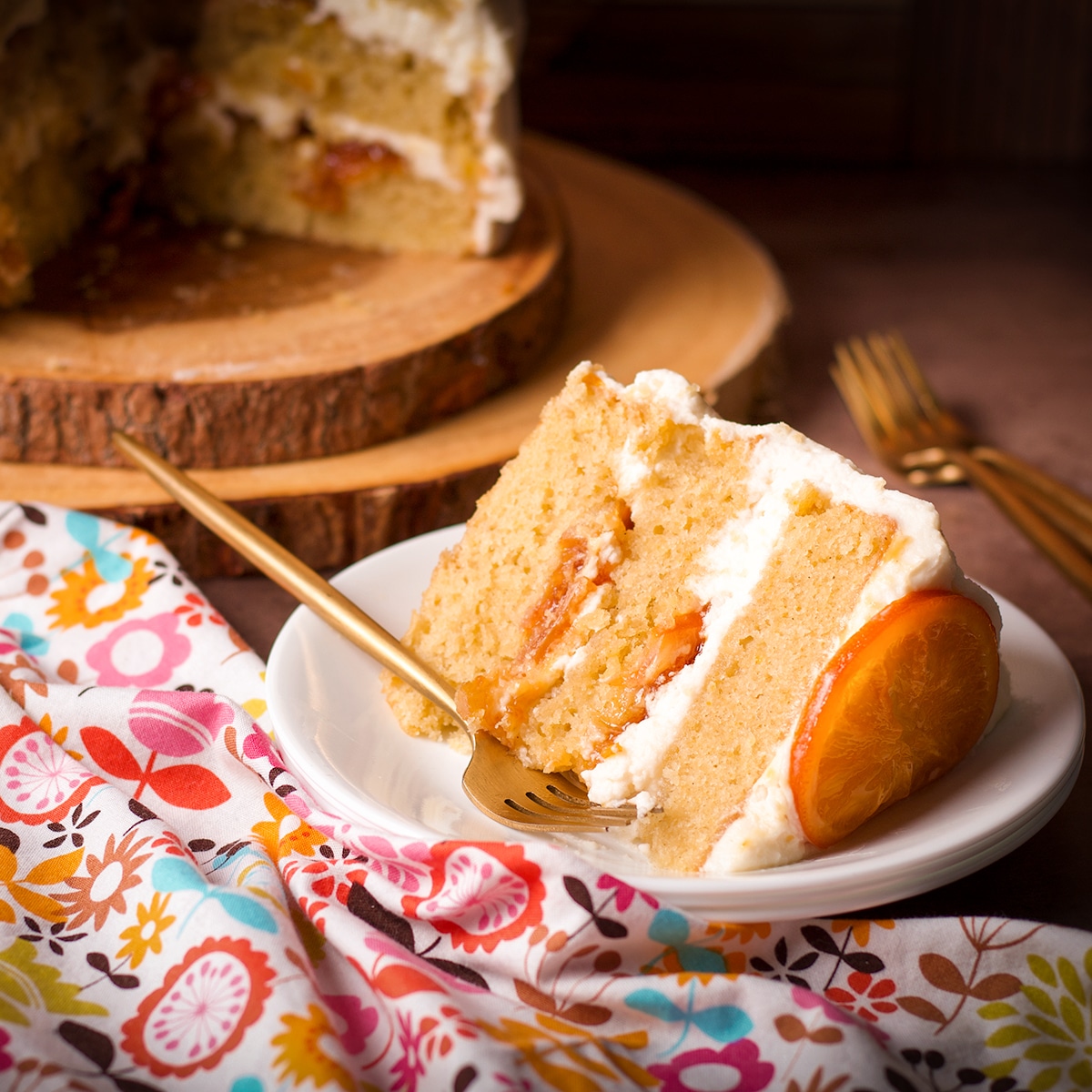
Storage and Make Ahead Instructions
This cake stays moist and fresh tasting for several days especially if you opt to brush the layers with orange liquor.
Even if you leave the orange liquor out, a completely assembled and frosted orange olive oil cake will keep well in the refrigerator for at least 3 days. Leftover cake, when stored in the refrigerator, will still be delicious 4 or 5 days after the cake is cut.
It's very important to refrigerate the cake once it's frosted. Mascarpone frosting is, of course, dairy-based and should not be left out at room temperature for more than 3 or 4 hours.
Once frosted, the cake cannot be frozen (Mascarpone Frosting doesn't freeze well). But, the individual orange olive oil cake layers can be frozen for up to 3 months. Wrap them in a layer or two of plastic wrap then in a layer of aluminum foil to prevent freezer burn. If you opt to brush the cake layers with orange liquor, do that before freezing them.
There's no need to thaw frozen cake layers before filling and decorating but you will want to allow enough time for the cake to thaw before serving.
- Orange marmalade can be prepared up to 2 weeks in advance and stored in a covered container in the refrigerator.
- Mascarpone frosting can be prepared up to 5 days in advance and stored in a covered container in the refrigerator. Re-whip it before using to make it easier to smooth over the cake.
- Candied orange slices can be prepared up to a month ahead of time and require no refrigeration. Store them in an air-tight container at room temperature with parchment separating layers of slices to prevent them from sticking together.
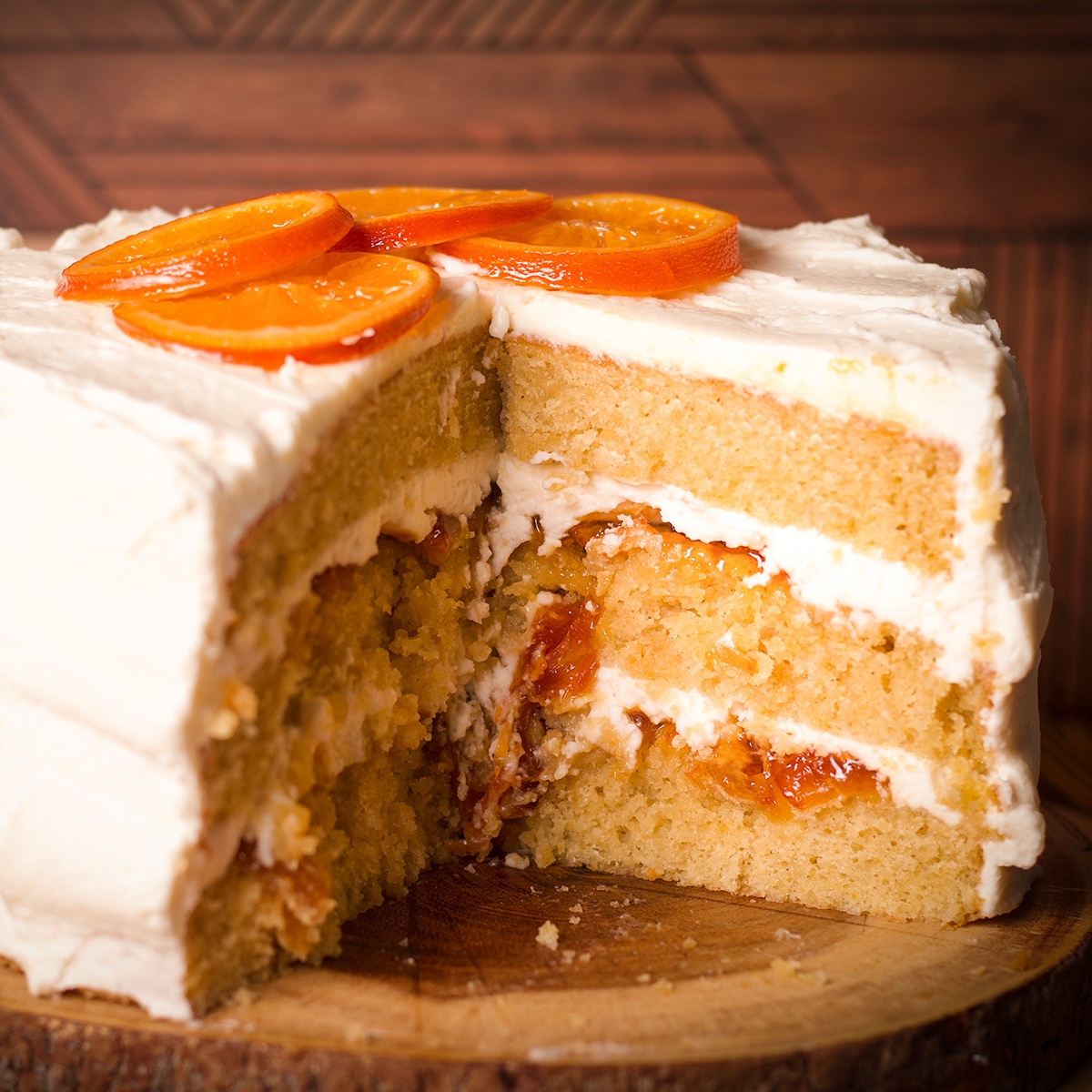
More Citrus-Flavored Recipes
Hey there citrus lover. Check out these popular citrusy treats:

+ Subscribe to my newsletter for new and exclusive recipes in your in-box every month! As a full time traveler, living, working, cooking, and baking from a 5th wheel RV, it's also where I share our experiences of life on the road.
If you give this recipe a try, let me know! Scroll down to rate this recipe and leave a comment for me, or take a picture and tag it @ofbatteranddough on Instagram.
Happy baking!
📖 Recipe
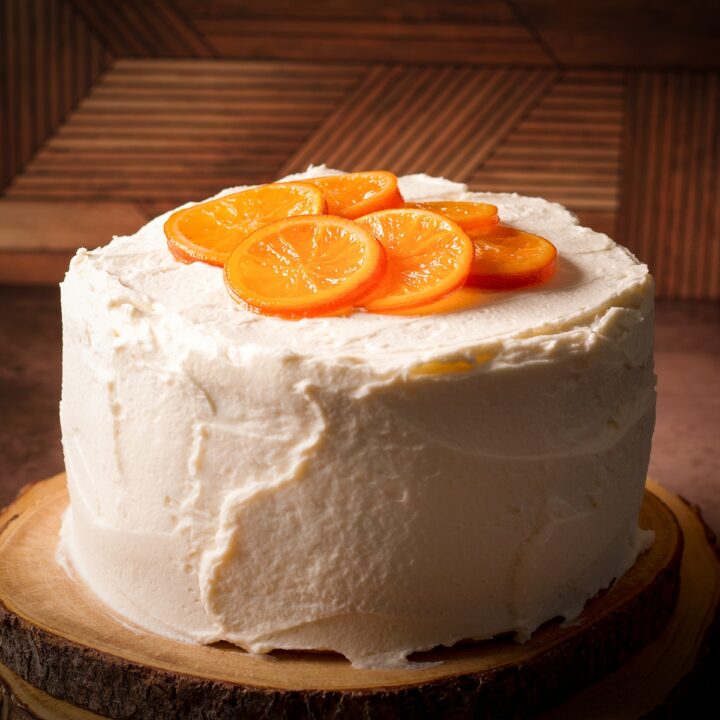
Orange Olive Oil Cake with Mascarpone Frosting
This light, tender, impossibly moist orange olive oil cake has a gorgeous, subtle natural orange flavor thanks to orange-infused olive oil. When layered with orange marmalade and creamy mascarpone frosting it's a light and creamy cake that's bursting with bright citrus flavor.
Ingredients
- 1 cup (200 grams) extra virgin olive oil
- 2 oranges (any variety)
- 2 ½ cups (300 grams) cake flour
- 1 teaspoon baking powder
- ¼ teaspoon baking soda
- 1 teaspoon ground cardamom
- 1 teaspoon kosher salt OR ½ teaspoon table salt
- 4 large eggs
- ¾ cup (170 grams) buttermilk
- ¼ cup (56 grams) orange juice
- 1 tablespoon vanilla
- 2 cups (400 grams) granulated sugar
To Assemble and Decorate:
- 4-6 tablespoons orange liquor (optional; see note below)
- 1 cup (12 ounces/ 340 grams) orange marmalade, prepared or homemade (scroll up for instructions on how to make it)
- Mascarpone Frosting
- Candied Orange Slices, for decorating and serving
Instructions
- Make quick orange-infused olive oil: Cut the peel from 2 oranges and place them in the bowl of a food processor or a high-powered blender. (Try to leave most of the white part, the pith, behind and use only the orange peel.) Add 1 cup extra virgin olive oil and blend/ process until smooth. Set aside. (This can be done up to 48 hours in advance. Store in an airtight container at room temperature.)
- Prepare 2 or 3 round cake pans as follows: Coat the inside of the pans with a thin layer of vegetable shortening or butter. Cut a piece of parchment to fit inside the pan, covering the bottom. Coat the parchment with vegetable shortening or butter. Sprinkle a tablespoon or two of flour inside the pan and shake it around to coat. Shake out the excess flour. (More information about how to prepare cake pans for baking.) *See note below about whether to use 2 or 3 cake pans.
- Heat oven to 350 degrees F (176 degrees C).
- Add the cake flour, baking powder, baking soda, cardamom, and salt to a medium size bow and stir with a wire whisk to combine.
- Add the orange-infused olive oil, eggs, buttermilk, orange juice, vanilla, and sugar to the bowl of an electric mixer fitted with the whisk attachment and beat on medium-high speed for 2-3 minutes to emulsify the ingredients.
- Fit the mixer with the paddle attachment and with the mixer running on low, add the dry ingredients. Beat just until combined. Remove the bowl from the mixer and use a spatula to stir the batter a few times, scraping around the bottom and sides of the bowl, to make sure everything is well blended.
- Distribute the batter between the cake pans. This recipe makes 1500 grams of batter, so if you want to be precise, measure 500 grams of batter into each of 3 cake pans. (See note below about using only 2 cake pans.)
- Bake the cakes in the center of the oven for about 28 - 33 minutes. (If using only two cake pans, the thicker cake will take up to 60 minutes to bake.) To test that the cakes are done, insert a toothpick in the center of the layers and remove it. If you see raw batter on the toothpick, bake for a bit longer.
- Allow the cakes to cool in their pans for 5 minutes. Carefully turn the cakes out onto wire racks and allow them to cool completely before assembling and frosting.
To assemble, frost, and decorate this cake:
*Scroll up for photos that demonstrate how to fill and frost this cake.
- If you've baked the cakes in two cake pans, use a serrated knife to cut the thick cake layer in half horizontally. Brush the top of each of the three layers with orange liquor (optional).
- Place one of the cake layers in the center of a cake board or serving platter. Spread about ½ cup of orange marmalade over the cake leaving at least an inch of space around the edge of the cake.
- Scoop some of the mascarpone frosting into a decorator/ pastry bag or a large zip-top bag. Clip about an inch from the tip of the bag or from the corner of the zip-top bag. Pipe a ring of frosting around the edge of the cake then pipe some frosting over the marmalade. Use a knife or a flat, offset icing spatula to spread the frosting over the marmalade.
- Top the first layer of cake with a second layer and repeat the process: spread with marmalade then cover the marmalade with frosting.
- Top the second layer with the third layer of cake. Scoop a large amount of frosting onto the top of the cake. Using an offset icing spatula, spread the frosting across the top of the cake and over the sides, smoothing it over the sides of the cake as you do to cover the cake completely.
- Decorate the top of the cake with candied orange slices. Serve immediately or cover loosely with plastic wrap or the domed top of a cake stand and refrigerate until ready to serve. This cake will keep well in the refrigerator for 2-3 days.
Notes
- No buttermilk? No problem. DIY Buttermilk: How to make your own
- If you only have two cake pans, or if only two pans will fit inside your oven at one time, you can bake ⅓ of the batter in one pan and ⅔ of the batter in the other pan. Allow extra time for the thicker cake to bake. Once the cakes have cooled, split the larger cake in ½ horizontally for a total of 3 layers. This recipe makes a total of 1500 grams of batter. So, if you want to be precise, fill one pan with 500 grams of batter and the other pan with 1000 grams of batter.
- To turn the cakes out onto wire racks, place a wire rack over the top of the cake pan. Holding the rack tightly against the cake pan, carefully flip the whole thing over so the cake slides out of the pan and onto the wire rack.
- Brushing the layers of this cake with some orange liquor gives it a more pronounced orange flavor and helps keep the cake moist for longer.
- Scroll up for instructions on how to make homemade orange marmalade. Or, if you'd like to order a jar, this Tiptree Orange Marmalade is my favorite brand.
- If you'd rather purchase candied orange slices than make them, these Trader Joe's Orange Slices are pretty good.
- I like to serve each slice of cake with a candied orange slice but the nutritional information below does not include candied orange slices.
Recommended Products
As an Amazon Associate and member of other affiliate programs, I earn from qualifying purchases.
Nutrition Information:
Yield: 12 Serving Size: 1/12th of the cakeAmount Per Serving: Calories: 771Total Fat: 44gSaturated Fat: 18gTrans Fat: 1gUnsaturated Fat: 23gCholesterol: 135mgSodium: 372mgCarbohydrates: 90gFiber: 1gSugar: 66gProtein: 7g


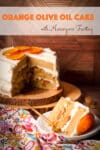
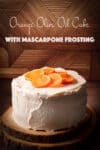
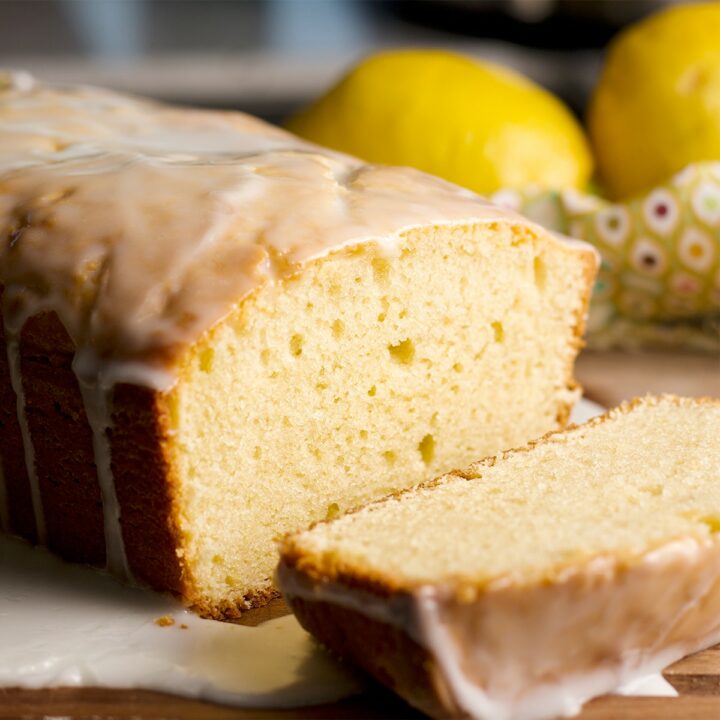
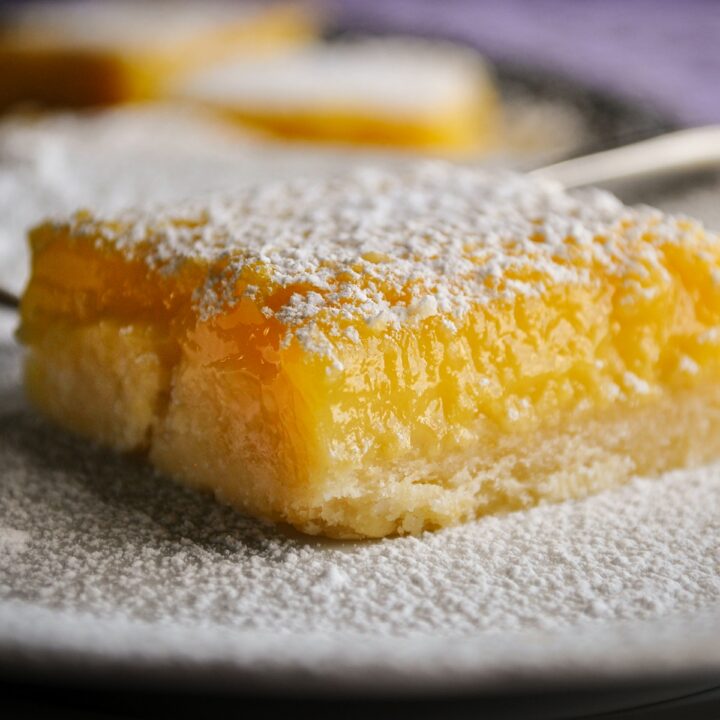
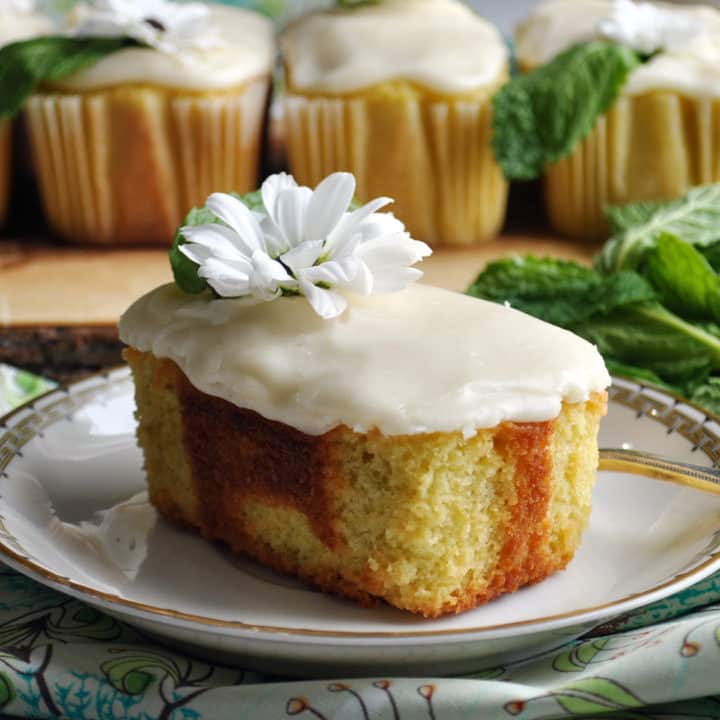






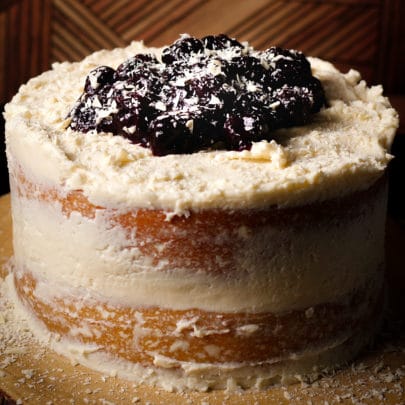
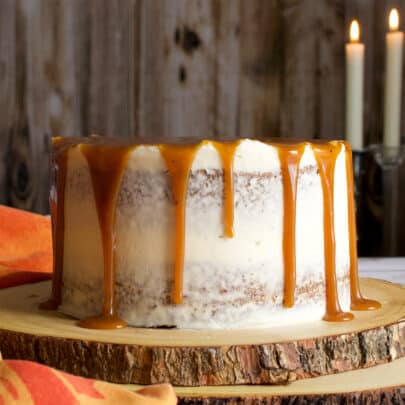
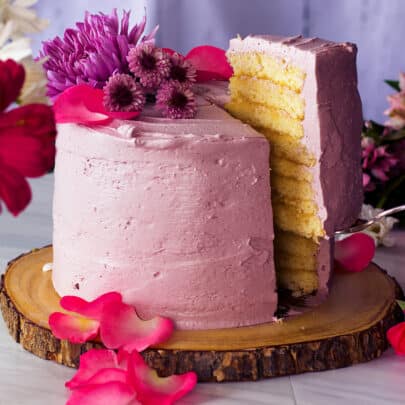
Jewell says
do you strain the infused olive oil? would it have small pieces of orange peel?
I would like to try making this cake, it looks amazing!
thank you
Rebecca Blackwell says
Hi Jewell! There is no need to strain the olive oil. If you really blend it, the entire orange is broken down so much that it doesn't affect the consistency of the cake at all. I hope that answers your question! And I do hope you make this cake! It's one of my all-time favorites! Please let me know if you have any other questions!
Mary says
I have a couple of questions. This recipe sounds amazing but I wonder if I can substitute some ground pistachios for part of the flour? And I was thinking of adding a flourless chocolate cake layer...I love the combination of the chocolate/orange/pistachio. Any suggestions will be appreciated. Thank you!
Rebecca Blackwell says
Hi Mary! I love those flavors too! And have several suggestions for you. First of all, since you like those flavors, you might want to check out this recipe for pistachio cardamom cake. The cake is frosted with cream cheese buttercream but would be divine with chocolate orange buttercream instead. For this cake, to incorporate chocolate and pistachio, I have a couple of ideas: Stir some mini-chocolate chips into the cake batter right before baking and then fill and frost the cake with Pistachio Italian Meringue Buttercream (scroll down to the section about flavoring Italian Meringue Buttercream). Or, stir some chopped pistachios into the cake batter right before baking and fill and frost the cake with chocolate orange buttercream.
I love the idea of substituting pistachios for flour, but in order for the pistachio flavor to come through, you'd have to use quite a bit of ground pistachios and I think that would mess up the cake's structure. This chocolate almond cake might be what you have in mind with the flourless chocolate cake layer. You could swap out the almond flour in that recipe for ground pistachios. It's not a completely flourless chocolate cake, but I think the texture is what you're looking for.
I hope that helps a little bit! Keep me posted! And, please let me know if you have any other questions!
Madison says
We had soo many oranges on our orange tree and I'd been looking for a way to use some of them. I love that this cake is made with olive oil, it makes it so flavorful and tender.
Rose says
This cake was super delicious and moist and the frosting brought it to another level.
Nikki P says
I have a question...
The quick method you have for making the orange infused olive oil requires processing it and that can heat the oil and make it bitter. Is there a way to infuse it slower or more gently so as to not process the oil?
Rebecca Blackwell says
Great question Nikki! If you process it just long enough to blend the peel into the oil it shouldn't heat it to the point where this would be a problem. But, one thing you could do to be sure is to process it in short bursts - blend for a couple of seconds, rest for a minute or two, blend for a couple of seconds, etc. This should prevent the oil from warming much at all. I hope that helps! Please let me know if you have any other questions! And I'd love to hear what you think of this cake after you make it! xo